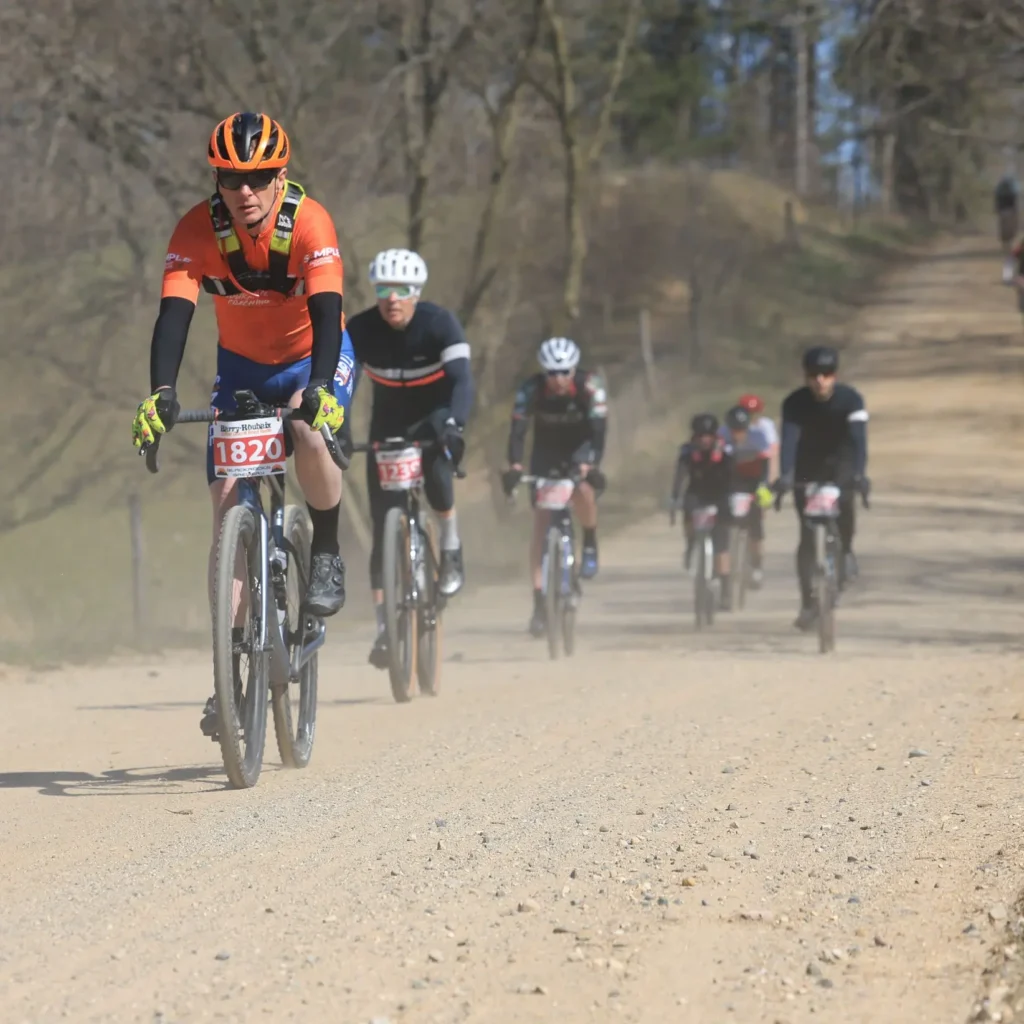Dial In Your Warm-Ups for Endurance Events: Maximizing Speed Without Burning Matches
I know a pro cyclocross racer who does a warmup before the race that is so intense I wonder if the rider was burning too many matches before the race began.
Warming up before a race is tricky: Too much and you’re burning matches before the event even starts, but too little, and you’re missing out on speed.
The best way to warm up for an endurance event lasting an hour or more typically involves a combination of cardiovascular activity, dynamic stretching, and mental preparation.
I’ll provide a sample warmup at the end of the article, once we understand what happens and why we need a warmup.
We’ll also include a short discussion of what to do the day before your event to prepare.

General outline of warmups
Here’s a general outline based on available research:
- Cardiovascular Warm-Up: Begin with a light cardiovascular warm-up to gradually increase your heart rate and blood flow to your muscles. This could involve jogging, cycling, or using an elliptical machine for about 5-10 minutes at a moderate intensity.
- Dynamic Stretching: Perform dynamic stretches, even yoga movements, that mimic the movements you’ll be doing during the endurance event. These stretches help improve flexibility, increase blood flow to the muscles, and reduce the risk of injury. Examples include leg swings, arm circles, walking lunges, and high knees.
- Specific Movement Drills: Incorporate specific movement drills relevant to your endurance activity. For example, if you’re a runner, include drills like high knees, butt kicks, and skipping to improve running mechanics and activate key muscle groups.
- Mental Preparation: Use the warm-up period to mentally prepare for the event. Visualize yourself performing well, focus on your goals, and use positive affirmations to build confidence.
- Hydration and Nutrition: Make sure you’re properly hydrated and fueled before starting the event. Drink water leading up to the event and consider consuming a light, easily digestible snack if needed.
- Final Preparations: In the minutes leading up to the event, perform any final mobility exercises or stretches that help you feel loose and ready to perform. Also, ensure that you’re wearing appropriate clothing and gear for the conditions.
Studies about warmups
The goal of a warm-up is to prime your aerobic system (VO2) and warm your body and muscles.
This study found that warmups contribute to increased oxygen uptake in the muscles after a warmup.
This study also showed that warmups generally increased performance.
This study saw some gains in running economy with a plyometric warmup. The runners were doing some hopping before the test and found improved running economy.
This study and this study both argue against long and intense warmups and advocate for lower-intensity aerobic efforts followed by a few activation sprint efforts.
Mental preparation before a race
It’s always important to get your head in the game before an event.
This could mean a lot of different things to different everyday athletes.
- Visualization: Visualization involves mentally rehearsing the race from start to finish, imagining yourself performing at your best. Visualize the course, the environment, and how you will navigate different sections of the race with confidence and determination. Picture yourself crossing the finish line feeling strong and accomplished. Visualization can help reduce anxiety and build confidence.
- Positive Self-Talk: Use positive affirmations and self-talk to boost confidence and motivation. Replace negative thoughts or doubts with positive statements such as “I am prepared,” “I am strong,” or “I can do this.” Repeat these affirmations during your warm-up to reinforce a positive mindset.
- Controlled Breathing: Practice deep breathing exercises to calm your nerves and center your focus. Incorporate deep, diaphragmatic breathing into your warm-up routine to promote relaxation and reduce tension in the body. Controlled breathing can help manage pre-race jitters and enhance mental clarity.
- Mindfulness and Present Moment Awareness: Stay present and focused on the present moment rather than worrying about the future or dwelling on past performances. Practice mindfulness techniques such as body scans, where you mentally check in with each part of your body, or mindfulness meditation to cultivate a calm and centered mindset.
- Pre-Race Routine: Establish a pre-race routine that helps you mentally prepare and get into the right mindset. This routine could include specific activities or rituals that you perform before every race, such as listening to motivating music, doing a short meditation, or engaging in a dynamic warm-up. Having a consistent pre-race routine can help signal to your mind and body that it’s time to perform.
- Adaptability: Be mentally flexible and prepared to adjust your race plan if necessary. Races don’t always go as planned, and being able to adapt to changing conditions or unexpected challenges is essential for success. Stay adaptable and maintain a positive attitude regardless of the circumstances.
Create your own routines
I don’t have a strict routine but generally, here is what I do: I get to the venue early enough to stay relaxed.
I change into my kit and ride or walk the course, depending on the event and availability.
Cyclocross races require more study of the course, so I want to get some laps in.
Gravel races, since they’re long, require less warmup, so I check out the start and the finish.
I make sure I stay hydrated and eat something an hour before.
For cross races, I get the trainer set up and set out all of my clothing and gear so it’s easy to transition from the trainer to putting on my skinsuit and having shoes, helmet, gloves, etc., all ready to go.
I get to the start line as late as possible after the bike warmup to maintain the heat in my muscles.
Prepare yourself the day before
The day before an endurance event, such as a running race or cycling competition, is crucial for ensuring that athletes are properly prepared both physically and mentally.
Here are some key steps endurance athletes can take to get their bodies ready for the event:
- Rest and Recovery: The day before the event is not the time to push hard in training. Instead, focus on rest and recovery to allow your body to fully recover from previous workouts and be fresh for the event. Avoid strenuous exercise that could lead to fatigue or muscle soreness.
- Stay Hydrated: Proper hydration is essential for optimal performance. Drink plenty of fluids throughout the day to ensure that you’re well-hydrated leading up to the event. However, be mindful not to overhydrate, as this can dilute electrolyte levels.
- Carbohydrate Loading: If the event is longer in duration (e.g., a marathon or long-distance cycling race), consider increasing your carbohydrate intake the day before to top up glycogen stores in the muscles and liver. Focus on consuming complex carbohydrates such as whole grains, fruits, and vegetables.
- Finalize Nutrition Plan: Plan your meals and snacks for the day before the event, making sure to choose foods that are familiar and easily digestible. Avoid trying new foods that could upset your stomach or cause gastrointestinal issues during the event.
- Visualize Success: Spend some time visualizing yourself performing well during the event. Visualizing success can help build confidence and mental readiness for the challenges ahead. Imagine yourself crossing the finish line feeling strong and accomplished.
- Gather Gear and Equipment: Lay out all the gear and equipment you’ll need for the event, including clothing, shoes, hydration packs, nutrition, and any other essentials. Double-check that everything is in good condition and ready to go.
- Relax and De-Stress: Minimize stress and anxiety by engaging in activities that help you relax and unwind. This could include meditation, deep breathing exercises, or spending time with friends and family.
- Early Bedtime: Aim to get a good night’s sleep to ensure you’re well-rested and refreshed on the morning of the event. Establish a bedtime routine that promotes relaxation and helps you fall asleep easily.
The workout the day before
Essentially, you’re doing a warmup on the day before.
Do a short easy workout with one or two high-intensity efforts for a couple of minutes.
For example, do a five to 10-minute easy run followed by some race pace efforts.
As another example, do a 10 to 15-minute easy ride, followed by a 20-second VO2max effort followed by a two-minute threshold interval. Finish with some easy pedaling.
Remember, there’s no more training to do be done.
Prime the pump and be mentally and physically ready to go.
The warmup
Here’s the warmup I give to my athletes:
Run or ride for eight minutes at a very easy pace.
Increase speed to a tempo pace for two minutes, then return to an easy pace.
Increase speed to a threshold pace for two minutes, then return to an easy pace.
Finally, do three 20-second VO2max type efforts where you prime the aerobic pump and get your muscles warm.
For mountain bike, crits, or cyclocross races, the starts are fast, so you need to be primed to be ready to go.
It’s also important to keep your muscles warm, so if it’s cold outside, keep your body covered as much as possible.
Plus it’s good to eat a gel or some blocks to top off your glycogen and be ready to race.
Three things to know about warmups
- It’s important to do some kind of warmup before a race or other big effort.
- Keep your warmup short with a couple of short intense sprints.
- Keep you and your muscles warm between the end of your warmup and the start of your race.
Need more?
GET A FREE Core Strength and Stability training video when you opt in to receive my weekly blog posts about what works in endurance sports.
SIGN UP FOR A Virtual Coffee so we can discuss your goals, ask questions, and talk about making your endurance training more effective, fun, and Simple.
Paul Warloski is a:
- USA Cycling Level 2 Coach
- RRCA Running Coach
- Training Peaks Level 2 Coach
- RYT-200 Yoga Instructor
- Certified Personal Trainer





